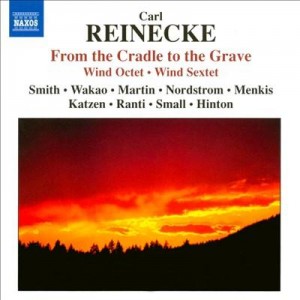Chamber music purely for wind ensembles was largely overlooked by Romantic composers and as a result Carl Reinecke’s genial Sextet and Octet for wind loom rather large in a sparse landscape. They are substantial, handsomely crafted works in which Reinecke’s skill for scoring yields a sonority at once rich, noble and beautifully balanced. Reinecke’s cycle of sixteen piano pieces Von der Wiege bis zum Grabe, here arranged for flute and piano by Ernesto Köhler, is a homage to his contemporary Robert Schumann yet loses nothing of the composer’s originality and vitality.
Reinecke, Carl
Octet, Op. 216
Boston Symphony Orchestra, members
I. Allegro moderato 00:08:43
2. II. Scherzo: Vivace 00:03:04
3. III. Adagio ma non troppo 00:05:53
4. IV. Finale: Allegro molto e grazioso 00:05:15
Von der Wiege bis zum Grabe, Op. 202 (arr. for flute and piano) (excerpts)
Smith, Fenwick, flute
Hinton, Hugh, piano
5. I. Spiel und Tanz 00:02:32
6. II. Rustiges Schaffen 00:02:35
7. III. O schone Maiennacht 00:03:49
8. IV. Hochzeitszug 00:03:19
9. V. Trost 00:01:40
10. VI. Geburtstagsmarsch 00:03:15
11. VII. Im Silberkranze 00:03:42
12. VIII. Abendsonne 00:03:38
Sextet, Op. 271
Boston Symphony Orchestra, members
13. I. Allegro moderato 00:08:07
14. II. Adagio molto 00:06:42
15. III. Finale: Allegro moderato ma con spirito 00:05:36
Total Playing Time: 01:07:50
For composers of chamber music in the romantic era, stringed instruments, with or without the addition of the piano, represented the sonic ideal. Apart from the quintets of Franz Danzi and Antoine Reicha, repertoire for pure wind ensembles was scarce. So Carl Reinecke’s genial Sextet and Octet for winds loom rather large in a sparse landscape, for they are substantial, handsomely crafted works. The traditional woodwind quintet can be tonally top-heavy, but Reinecke’s inclusion of a second horn in Op. 271, and additional parts for clarinet and bassoon in Op. 216, provide a sonorous and well balanced ensemble.
In Romantic chamber music, the ideal was the string quartet, as handed down from Haydn, Beethoven and Mozart. Schubert, Schumann, Brahms and their contemporaries filled the classical forms with romantic expression and drama, often adding a piano to complement and reinforce the string group, but woodwind instruments appeared only seldom, and almost always singly. The woodwind instrument most in favour was the clarinet, prized by the Romantics for its warm, blending tone and smooth legato. Weber, Schumann and Brahms each wrote fine chamber works for the clarinet, but comparable works including flute, oboe, horn or bassoon are scarce indeed. The return of the woodwinds as equals in chamber music would have to await the revolutionary advances of the twentieth century.
Carl Reinecke, the precocious child of a provincial music teacher, was an accomplished violinist and violist; he was also among Germany’s most prominent concert pianists. He had started composing at the age of seven, and continued throughout his long and enormously productive life, accumulating a catalogue of 288 opus numbers in all genres. Truly the complete musician, Reinecke also enjoyed a prominent and successful career as a conductor. In 1860 he was appointed music director of the Gewandhaus Orchestra of Leipzig and professor of piano and composition at the Conservatory, where he taught composers as varied as Bruch, Albéniz, and Janáãek. Today Reinecke is remembered primarily for his fine 1882 sonata for flute and piano Undine, a work which might have found its way onto this recording, except that it has already been recorded dozens of times.
Since the 1840s Mendelssohn and Schumann had been the leading lights of Leipzig’s flourishing musical life. Reinecke was an admirer and disciple of both, and his compositional style and artistic aims were much influenced by the older masters. From about 1890, however, Brahms’s star was on the rise, and Reinecke’s accomplishments, though highly regarded, were increasingly overshadowed by those of the greater composer. Around this time, wind instruments began to figure more prominently in Reinecke’s output – a development that may largely be explained by his desire to avoid competing with Brahms on his own turf.
At least one commentator, explaining why Brahms so overshadowed Reinecke, suggested that the production of richness of tone was not Reinecke’s forte. But in both the Sextet and the Octet Reinecke handily avoids any such shortcoming; his decades of experience as an orchestral conductor gave him a thorough knowledge of the wind instruments, and the music invariably sounds well. In the Adagio of the Octet, for example, his skilful scoring yields a sonority at once rich, noble and beautifully balanced. Though the skill with which he develops and manipulates his material is sometimes more memorable than the tunes themselves, his mastery of form is secure, his harmonic vocabulary sophisticated if not innovative. Indeed the only mystery attending these genial pieces is that they should have been so long and so widely overlooked, and that they should have had to wait most of a century for their first recording.
The opening phrases of the Octet show immediately the rich, warm, blended sound that can be achieved with pairs of bassoons, horns, and clarinets supporting the upper voices of oboe and flute – a sonority that even Brahms might have envied. The first movement is in the expected sonata-allegro form (all repeats are taken in these performances), but in place of the expected slow movement, Reinecke continues with a scherzo of Mendelssohnian lightness and charm, which ends Puckishly with the two horns alone. The Adagio, the expressive centre of the Octet, is laid out in three broad, sonorous climaxes, the last carried by the oboe. The following rondo, marked Allegro molto, provides the strongest possible contrast. It is a spirited romp led by the flute and clarinet, with opportunities for all to show their virtuosity and panache.
The Sextet, composed approximately thirteen years after the Octet, shows in its first movement greater contrapuntal interest than the earlier work. The entire first movement is based on a falling melodic motive, heard already in the first bar, and repeated three times by the horn at the end of the movement. Reinecke calls attention to this motive a mere eighteen seconds into the movement, when it is heard in close succession in five different instruments – a sort of microscopic development passage. The remaining movements are in ternary, or A-B-A form. The Adagio has at its centre a sprightly Vivace ma non troppo dominated by the flute; and the Finale has at its centre a lilting, waltz-like episode marked Moderato con grazia – the better to set up the rambunctious coda.
Reinecke’s cycle of sixteen piano pieces Von der Wiege bis zum Grabe, Op. 202, (From the Cradle to the Grave), was published in 1888. It was a resounding success. A biography of Reinecke was issued four years later by his principal publisher, J. H. Zimmerman, including, at the back of the book, several advertisements for Reinecke’s recent works. A full page is devoted to Op. 202, with glowing critical notices, a report that it was already in its tenth printing, and descriptions of numerous unattributed arrangements, including the present one for flute and piano. It was typical practice for composers as successful as Reinecke to entrust the making of such arrangements to lesser composers. Schumann, pressed by his publisher some forty years earlier for a piano four-hand arrangement of his Third Symphony, had in fact recommended the young Reinecke.
The present arrangement was made be the flautistcomposer Ernesto Köhler. He selected eight of the sixteen pieces, retaining their original order and selfexplanatory titles. In these charming Schumannesque miniatures Reinecke’s indebtedness to the older master is underscored by his quotation of the Grossvatertanz (Grandfather’s Dance), a seventeenth-century tune quoted by Schumann in his own works, and traditionally the last dance of a ball. Reinecke introduces this tune in Abendsonne (Sunset) and builds it up to a climax of considerable vitality, as we might expect from a composer who retained his creative energy into advanced old age.




































